Coventry University: 5006MKT Consumer Behaviour Exam Solution
VerifiedAdded on 2023/06/11
|5
|1957
|174
Quiz and Exam
AI Summary
This document provides solutions to a Consumer Behaviour exam, focusing on key marketing concepts. It addresses motivational conflict, explaining the three types and how marketers leverage them, particularly in challenging product categories like insurance. The solution also defines stimulus generalization and discrimination, illustrating their application in FMCG with examples from Unilever and supermarket chains. Furthermore, it explores sensory marketing, detailing how taste, sight, touch, smell, and hearing are used to create effective campaigns, exemplified by mobile phone marketing strategies. The document emphasizes the importance of engaging multiple senses for high-value products to comprehensively convert potential customers. Desklib provides access to a wealth of similar resources for students.
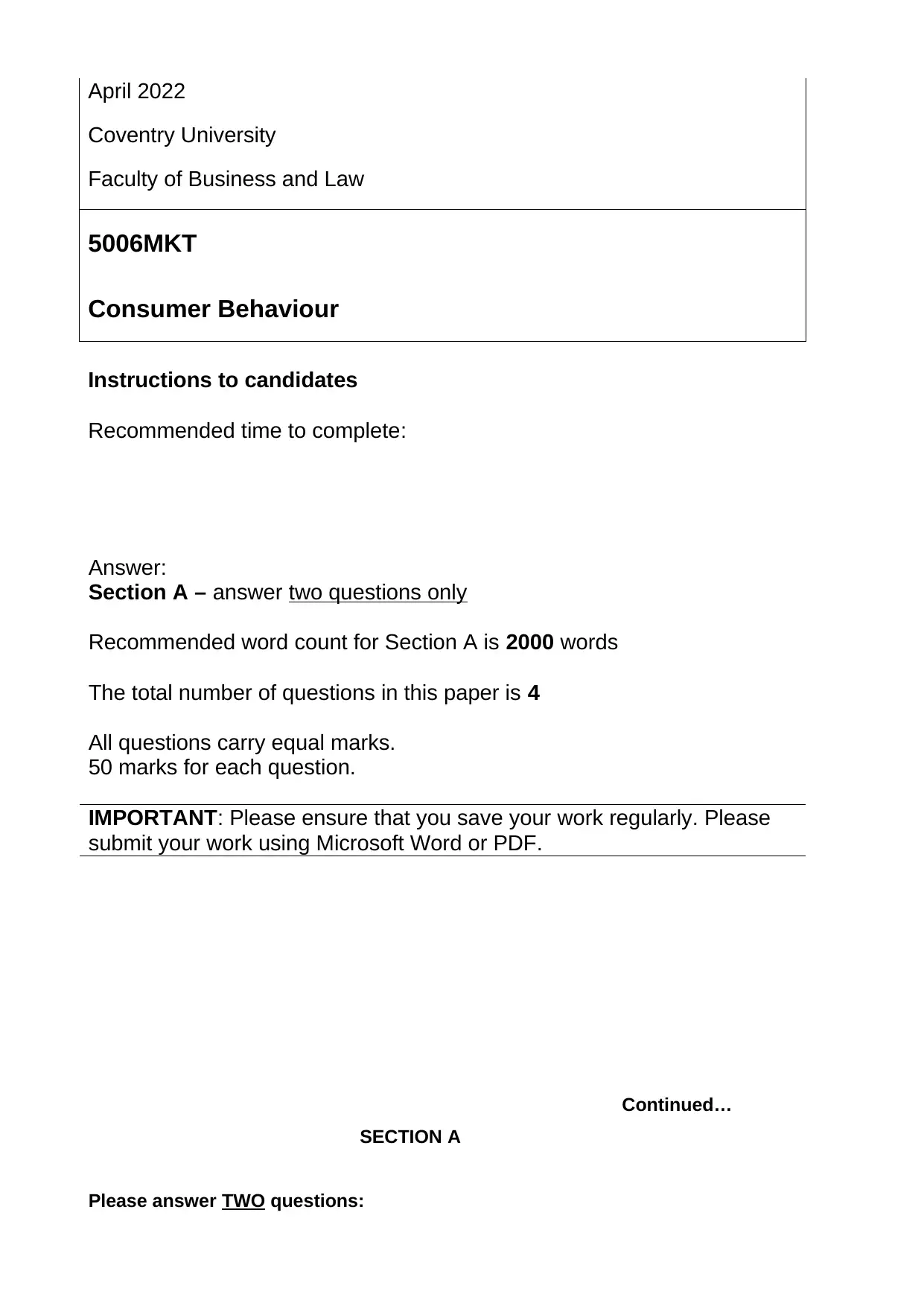
April 2022
Coventry University
Faculty of Business and Law
5006MKT
Consumer Behaviour
Instructions to candidates
Recommended time to complete:
Answer:
Section A – answer two questions only
Recommended word count for Section A is 2000 words
The total number of questions in this paper is 4
All questions carry equal marks.
50 marks for each question.
IMPORTANT: Please ensure that you save your work regularly. Please
submit your work using Microsoft Word or PDF.
Continued…
SECTION A
Please answer TWO questions:
Coventry University
Faculty of Business and Law
5006MKT
Consumer Behaviour
Instructions to candidates
Recommended time to complete:
Answer:
Section A – answer two questions only
Recommended word count for Section A is 2000 words
The total number of questions in this paper is 4
All questions carry equal marks.
50 marks for each question.
IMPORTANT: Please ensure that you save your work regularly. Please
submit your work using Microsoft Word or PDF.
Continued…
SECTION A
Please answer TWO questions:
Paraphrase This Document
Need a fresh take? Get an instant paraphrase of this document with our AI Paraphraser
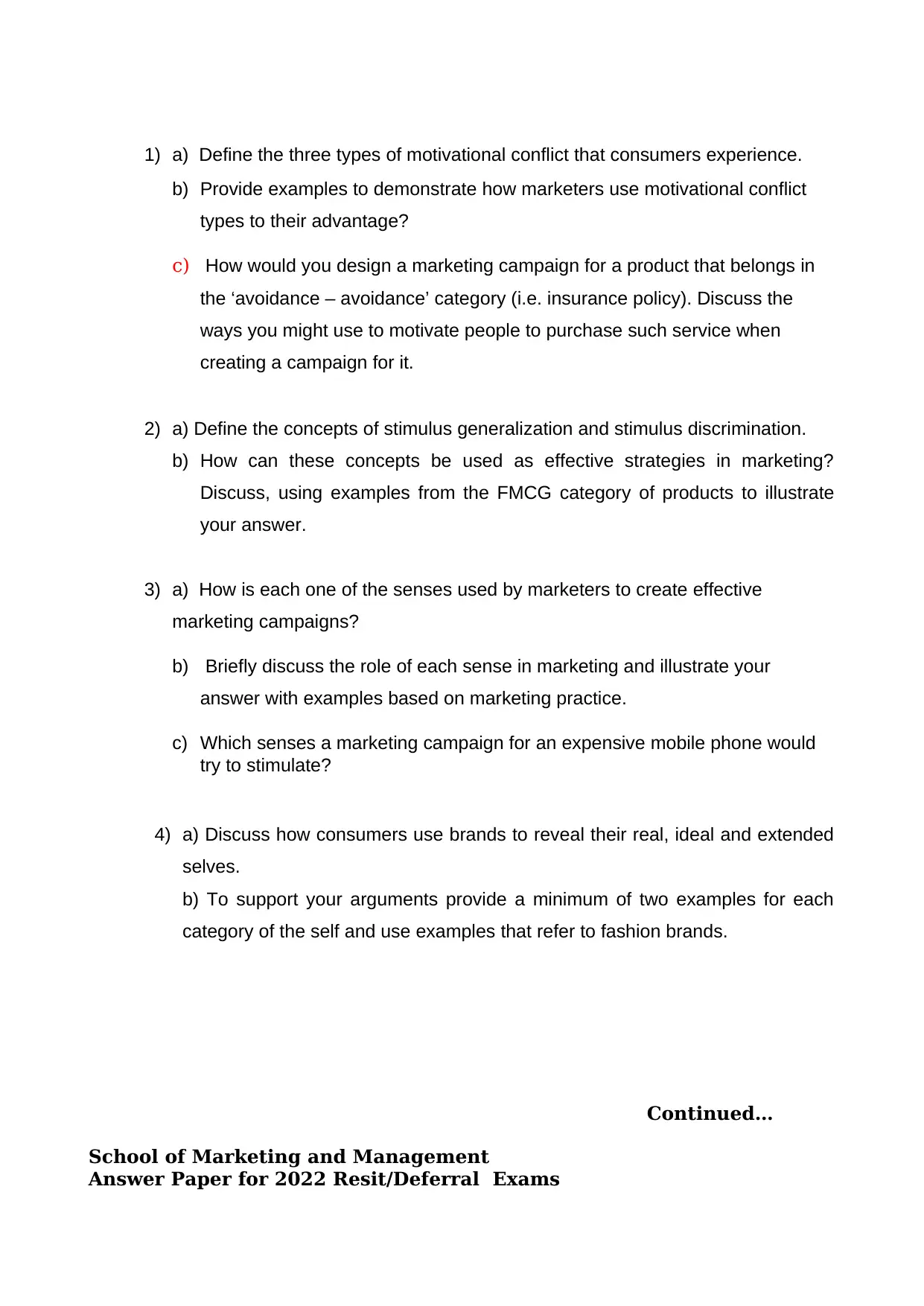
1) a) Define the three types of motivational conflict that consumers experience.
b) Provide examples to demonstrate how marketers use motivational conflict
types to their advantage?
c) How would you design a marketing campaign for a product that belongs in
the ‘avoidance – avoidance’ category (i.e. insurance policy). Discuss the
ways you might use to motivate people to purchase such service when
creating a campaign for it.
2) a) Define the concepts of stimulus generalization and stimulus discrimination.
b) How can these concepts be used as effective strategies in marketing?
Discuss, using examples from the FMCG category of products to illustrate
your answer.
3) a) How is each one of the senses used by marketers to create effective
marketing campaigns?
b) Briefly discuss the role of each sense in marketing and illustrate your
answer with examples based on marketing practice.
c) Which senses a marketing campaign for an expensive mobile phone would
try to stimulate?
4) a) Discuss how consumers use brands to reveal their real, ideal and extended
selves.
b) To support your arguments provide a minimum of two examples for each
category of the self and use examples that refer to fashion brands.
Continued…
School of Marketing and Management
Answer Paper for 2022 Resit/Deferral Exams
b) Provide examples to demonstrate how marketers use motivational conflict
types to their advantage?
c) How would you design a marketing campaign for a product that belongs in
the ‘avoidance – avoidance’ category (i.e. insurance policy). Discuss the
ways you might use to motivate people to purchase such service when
creating a campaign for it.
2) a) Define the concepts of stimulus generalization and stimulus discrimination.
b) How can these concepts be used as effective strategies in marketing?
Discuss, using examples from the FMCG category of products to illustrate
your answer.
3) a) How is each one of the senses used by marketers to create effective
marketing campaigns?
b) Briefly discuss the role of each sense in marketing and illustrate your
answer with examples based on marketing practice.
c) Which senses a marketing campaign for an expensive mobile phone would
try to stimulate?
4) a) Discuss how consumers use brands to reveal their real, ideal and extended
selves.
b) To support your arguments provide a minimum of two examples for each
category of the self and use examples that refer to fashion brands.
Continued…
School of Marketing and Management
Answer Paper for 2022 Resit/Deferral Exams
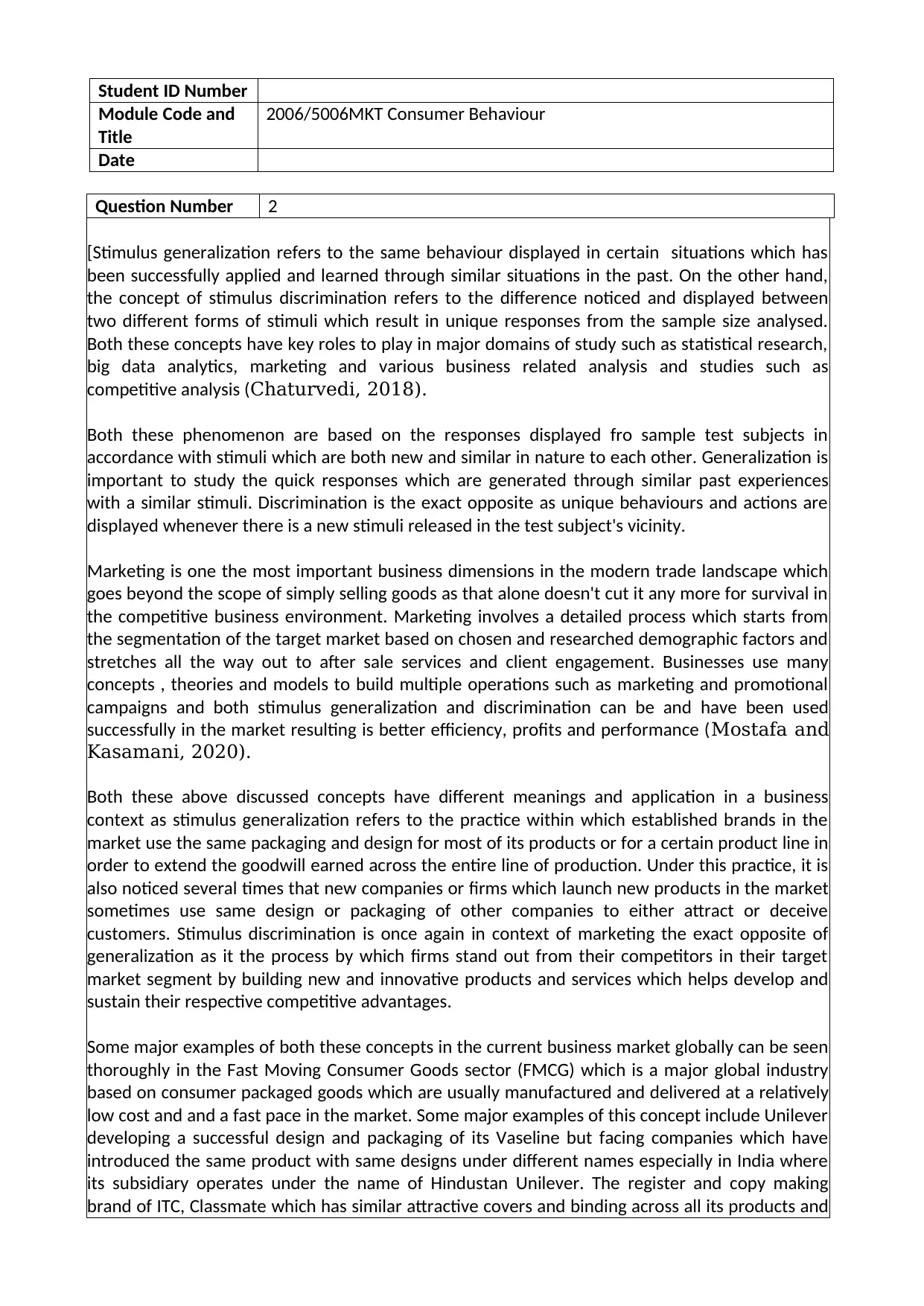
Student ID Number
Module Code and
Title
2006/5006MKT Consumer Behaviour
Date
Question Number 2
[Stimulus generalization refers to the same behaviour displayed in certain situations which has
been successfully applied and learned through similar situations in the past. On the other hand,
the concept of stimulus discrimination refers to the difference noticed and displayed between
two different forms of stimuli which result in unique responses from the sample size analysed.
Both these concepts have key roles to play in major domains of study such as statistical research,
big data analytics, marketing and various business related analysis and studies such as
competitive analysis (Chaturvedi, 2018).
Both these phenomenon are based on the responses displayed fro sample test subjects in
accordance with stimuli which are both new and similar in nature to each other. Generalization is
important to study the quick responses which are generated through similar past experiences
with a similar stimuli. Discrimination is the exact opposite as unique behaviours and actions are
displayed whenever there is a new stimuli released in the test subject's vicinity.
Marketing is one the most important business dimensions in the modern trade landscape which
goes beyond the scope of simply selling goods as that alone doesn't cut it any more for survival in
the competitive business environment. Marketing involves a detailed process which starts from
the segmentation of the target market based on chosen and researched demographic factors and
stretches all the way out to after sale services and client engagement. Businesses use many
concepts , theories and models to build multiple operations such as marketing and promotional
campaigns and both stimulus generalization and discrimination can be and have been used
successfully in the market resulting is better efficiency, profits and performance (Mostafa and
Kasamani, 2020).
Both these above discussed concepts have different meanings and application in a business
context as stimulus generalization refers to the practice within which established brands in the
market use the same packaging and design for most of its products or for a certain product line in
order to extend the goodwill earned across the entire line of production. Under this practice, it is
also noticed several times that new companies or firms which launch new products in the market
sometimes use same design or packaging of other companies to either attract or deceive
customers. Stimulus discrimination is once again in context of marketing the exact opposite of
generalization as it the process by which firms stand out from their competitors in their target
market segment by building new and innovative products and services which helps develop and
sustain their respective competitive advantages.
Some major examples of both these concepts in the current business market globally can be seen
thoroughly in the Fast Moving Consumer Goods sector (FMCG) which is a major global industry
based on consumer packaged goods which are usually manufactured and delivered at a relatively
low cost and and a fast pace in the market. Some major examples of this concept include Unilever
developing a successful design and packaging of its Vaseline but facing companies which have
introduced the same product with same designs under different names especially in India where
its subsidiary operates under the name of Hindustan Unilever. The register and copy making
brand of ITC, Classmate which has similar attractive covers and binding across all its products and
Module Code and
Title
2006/5006MKT Consumer Behaviour
Date
Question Number 2
[Stimulus generalization refers to the same behaviour displayed in certain situations which has
been successfully applied and learned through similar situations in the past. On the other hand,
the concept of stimulus discrimination refers to the difference noticed and displayed between
two different forms of stimuli which result in unique responses from the sample size analysed.
Both these concepts have key roles to play in major domains of study such as statistical research,
big data analytics, marketing and various business related analysis and studies such as
competitive analysis (Chaturvedi, 2018).
Both these phenomenon are based on the responses displayed fro sample test subjects in
accordance with stimuli which are both new and similar in nature to each other. Generalization is
important to study the quick responses which are generated through similar past experiences
with a similar stimuli. Discrimination is the exact opposite as unique behaviours and actions are
displayed whenever there is a new stimuli released in the test subject's vicinity.
Marketing is one the most important business dimensions in the modern trade landscape which
goes beyond the scope of simply selling goods as that alone doesn't cut it any more for survival in
the competitive business environment. Marketing involves a detailed process which starts from
the segmentation of the target market based on chosen and researched demographic factors and
stretches all the way out to after sale services and client engagement. Businesses use many
concepts , theories and models to build multiple operations such as marketing and promotional
campaigns and both stimulus generalization and discrimination can be and have been used
successfully in the market resulting is better efficiency, profits and performance (Mostafa and
Kasamani, 2020).
Both these above discussed concepts have different meanings and application in a business
context as stimulus generalization refers to the practice within which established brands in the
market use the same packaging and design for most of its products or for a certain product line in
order to extend the goodwill earned across the entire line of production. Under this practice, it is
also noticed several times that new companies or firms which launch new products in the market
sometimes use same design or packaging of other companies to either attract or deceive
customers. Stimulus discrimination is once again in context of marketing the exact opposite of
generalization as it the process by which firms stand out from their competitors in their target
market segment by building new and innovative products and services which helps develop and
sustain their respective competitive advantages.
Some major examples of both these concepts in the current business market globally can be seen
thoroughly in the Fast Moving Consumer Goods sector (FMCG) which is a major global industry
based on consumer packaged goods which are usually manufactured and delivered at a relatively
low cost and and a fast pace in the market. Some major examples of this concept include Unilever
developing a successful design and packaging of its Vaseline but facing companies which have
introduced the same product with same designs under different names especially in India where
its subsidiary operates under the name of Hindustan Unilever. The register and copy making
brand of ITC, Classmate which has similar attractive covers and binding across all its products and
⊘ This is a preview!⊘
Do you want full access?
Subscribe today to unlock all pages.

Trusted by 1+ million students worldwide
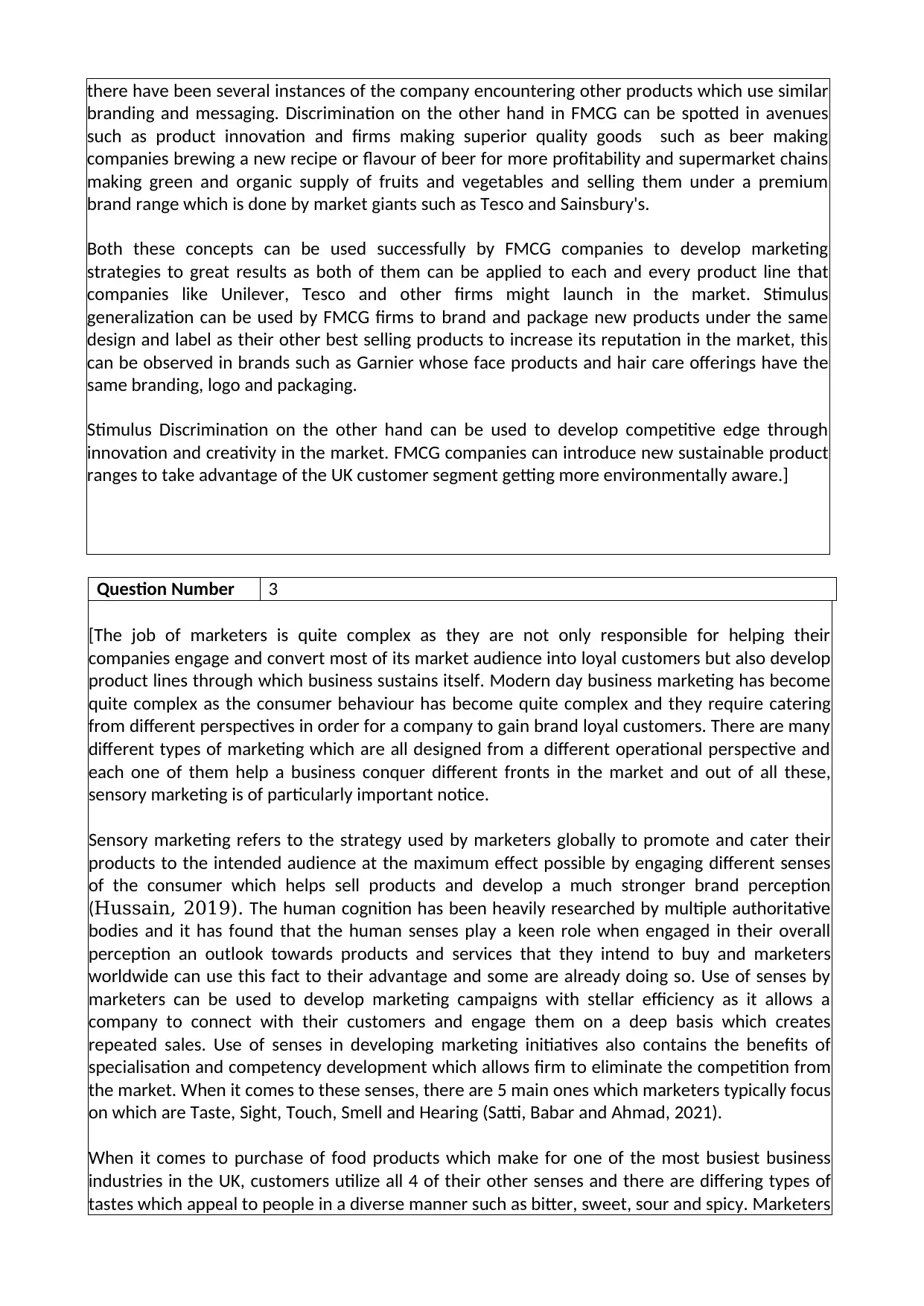
there have been several instances of the company encountering other products which use similar
branding and messaging. Discrimination on the other hand in FMCG can be spotted in avenues
such as product innovation and firms making superior quality goods such as beer making
companies brewing a new recipe or flavour of beer for more profitability and supermarket chains
making green and organic supply of fruits and vegetables and selling them under a premium
brand range which is done by market giants such as Tesco and Sainsbury's.
Both these concepts can be used successfully by FMCG companies to develop marketing
strategies to great results as both of them can be applied to each and every product line that
companies like Unilever, Tesco and other firms might launch in the market. Stimulus
generalization can be used by FMCG firms to brand and package new products under the same
design and label as their other best selling products to increase its reputation in the market, this
can be observed in brands such as Garnier whose face products and hair care offerings have the
same branding, logo and packaging.
Stimulus Discrimination on the other hand can be used to develop competitive edge through
innovation and creativity in the market. FMCG companies can introduce new sustainable product
ranges to take advantage of the UK customer segment getting more environmentally aware.]
Question Number 3
[The job of marketers is quite complex as they are not only responsible for helping their
companies engage and convert most of its market audience into loyal customers but also develop
product lines through which business sustains itself. Modern day business marketing has become
quite complex as the consumer behaviour has become quite complex and they require catering
from different perspectives in order for a company to gain brand loyal customers. There are many
different types of marketing which are all designed from a different operational perspective and
each one of them help a business conquer different fronts in the market and out of all these,
sensory marketing is of particularly important notice.
Sensory marketing refers to the strategy used by marketers globally to promote and cater their
products to the intended audience at the maximum effect possible by engaging different senses
of the consumer which helps sell products and develop a much stronger brand perception
(Hussain, 2019). The human cognition has been heavily researched by multiple authoritative
bodies and it has found that the human senses play a keen role when engaged in their overall
perception an outlook towards products and services that they intend to buy and marketers
worldwide can use this fact to their advantage and some are already doing so. Use of senses by
marketers can be used to develop marketing campaigns with stellar efficiency as it allows a
company to connect with their customers and engage them on a deep basis which creates
repeated sales. Use of senses in developing marketing initiatives also contains the benefits of
specialisation and competency development which allows firm to eliminate the competition from
the market. When it comes to these senses, there are 5 main ones which marketers typically focus
on which are Taste, Sight, Touch, Smell and Hearing (Satti, Babar and Ahmad, 2021).
When it comes to purchase of food products which make for one of the most busiest business
industries in the UK, customers utilize all 4 of their other senses and there are differing types of
tastes which appeal to people in a diverse manner such as bitter, sweet, sour and spicy. Marketers
branding and messaging. Discrimination on the other hand in FMCG can be spotted in avenues
such as product innovation and firms making superior quality goods such as beer making
companies brewing a new recipe or flavour of beer for more profitability and supermarket chains
making green and organic supply of fruits and vegetables and selling them under a premium
brand range which is done by market giants such as Tesco and Sainsbury's.
Both these concepts can be used successfully by FMCG companies to develop marketing
strategies to great results as both of them can be applied to each and every product line that
companies like Unilever, Tesco and other firms might launch in the market. Stimulus
generalization can be used by FMCG firms to brand and package new products under the same
design and label as their other best selling products to increase its reputation in the market, this
can be observed in brands such as Garnier whose face products and hair care offerings have the
same branding, logo and packaging.
Stimulus Discrimination on the other hand can be used to develop competitive edge through
innovation and creativity in the market. FMCG companies can introduce new sustainable product
ranges to take advantage of the UK customer segment getting more environmentally aware.]
Question Number 3
[The job of marketers is quite complex as they are not only responsible for helping their
companies engage and convert most of its market audience into loyal customers but also develop
product lines through which business sustains itself. Modern day business marketing has become
quite complex as the consumer behaviour has become quite complex and they require catering
from different perspectives in order for a company to gain brand loyal customers. There are many
different types of marketing which are all designed from a different operational perspective and
each one of them help a business conquer different fronts in the market and out of all these,
sensory marketing is of particularly important notice.
Sensory marketing refers to the strategy used by marketers globally to promote and cater their
products to the intended audience at the maximum effect possible by engaging different senses
of the consumer which helps sell products and develop a much stronger brand perception
(Hussain, 2019). The human cognition has been heavily researched by multiple authoritative
bodies and it has found that the human senses play a keen role when engaged in their overall
perception an outlook towards products and services that they intend to buy and marketers
worldwide can use this fact to their advantage and some are already doing so. Use of senses by
marketers can be used to develop marketing campaigns with stellar efficiency as it allows a
company to connect with their customers and engage them on a deep basis which creates
repeated sales. Use of senses in developing marketing initiatives also contains the benefits of
specialisation and competency development which allows firm to eliminate the competition from
the market. When it comes to these senses, there are 5 main ones which marketers typically focus
on which are Taste, Sight, Touch, Smell and Hearing (Satti, Babar and Ahmad, 2021).
When it comes to purchase of food products which make for one of the most busiest business
industries in the UK, customers utilize all 4 of their other senses and there are differing types of
tastes which appeal to people in a diverse manner such as bitter, sweet, sour and spicy. Marketers
Paraphrase This Document
Need a fresh take? Get an instant paraphrase of this document with our AI Paraphraser
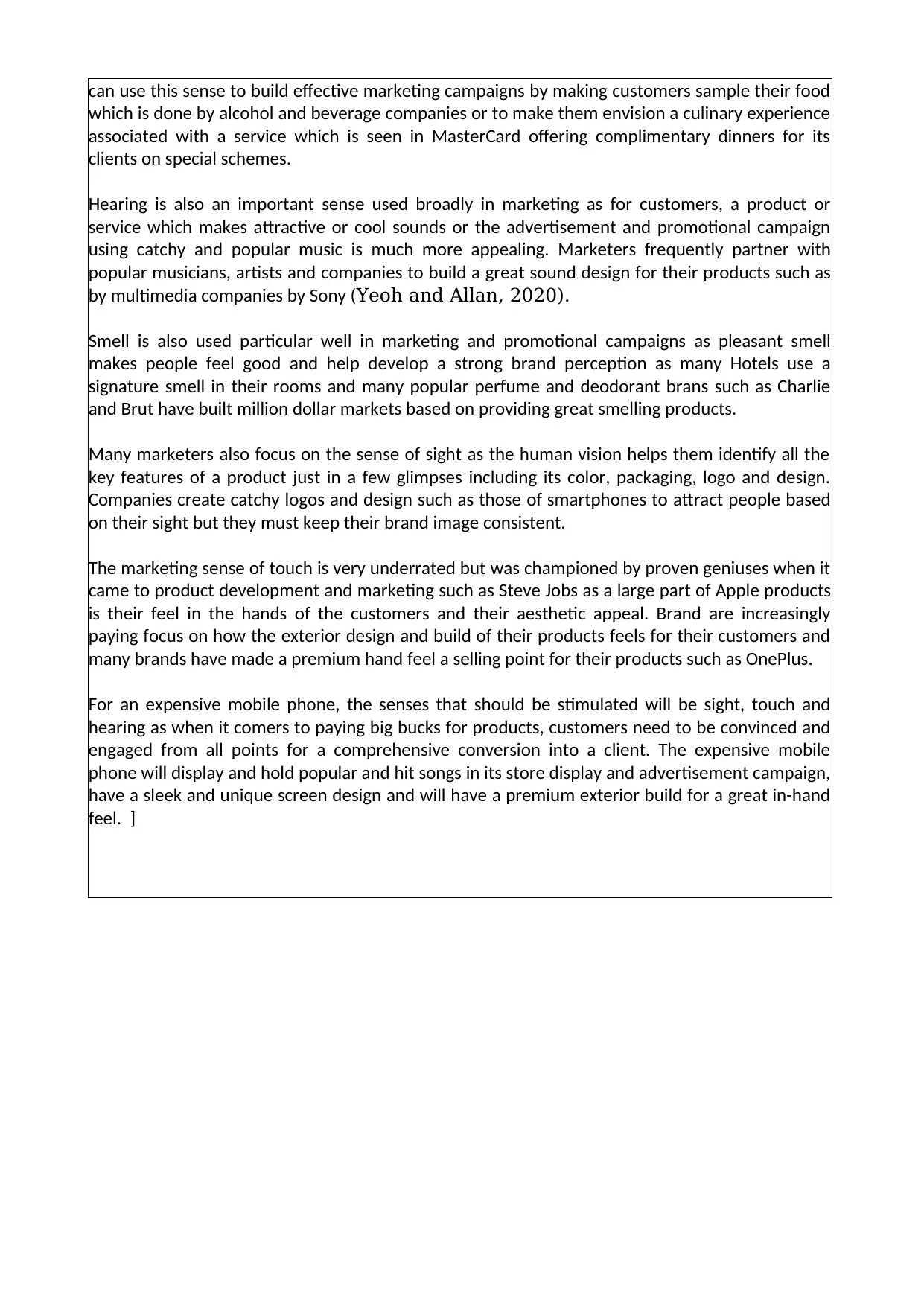
can use this sense to build effective marketing campaigns by making customers sample their food
which is done by alcohol and beverage companies or to make them envision a culinary experience
associated with a service which is seen in MasterCard offering complimentary dinners for its
clients on special schemes.
Hearing is also an important sense used broadly in marketing as for customers, a product or
service which makes attractive or cool sounds or the advertisement and promotional campaign
using catchy and popular music is much more appealing. Marketers frequently partner with
popular musicians, artists and companies to build a great sound design for their products such as
by multimedia companies by Sony (Yeoh and Allan, 2020).
Smell is also used particular well in marketing and promotional campaigns as pleasant smell
makes people feel good and help develop a strong brand perception as many Hotels use a
signature smell in their rooms and many popular perfume and deodorant brans such as Charlie
and Brut have built million dollar markets based on providing great smelling products.
Many marketers also focus on the sense of sight as the human vision helps them identify all the
key features of a product just in a few glimpses including its color, packaging, logo and design.
Companies create catchy logos and design such as those of smartphones to attract people based
on their sight but they must keep their brand image consistent.
The marketing sense of touch is very underrated but was championed by proven geniuses when it
came to product development and marketing such as Steve Jobs as a large part of Apple products
is their feel in the hands of the customers and their aesthetic appeal. Brand are increasingly
paying focus on how the exterior design and build of their products feels for their customers and
many brands have made a premium hand feel a selling point for their products such as OnePlus.
For an expensive mobile phone, the senses that should be stimulated will be sight, touch and
hearing as when it comers to paying big bucks for products, customers need to be convinced and
engaged from all points for a comprehensive conversion into a client. The expensive mobile
phone will display and hold popular and hit songs in its store display and advertisement campaign,
have a sleek and unique screen design and will have a premium exterior build for a great in-hand
feel. ]
which is done by alcohol and beverage companies or to make them envision a culinary experience
associated with a service which is seen in MasterCard offering complimentary dinners for its
clients on special schemes.
Hearing is also an important sense used broadly in marketing as for customers, a product or
service which makes attractive or cool sounds or the advertisement and promotional campaign
using catchy and popular music is much more appealing. Marketers frequently partner with
popular musicians, artists and companies to build a great sound design for their products such as
by multimedia companies by Sony (Yeoh and Allan, 2020).
Smell is also used particular well in marketing and promotional campaigns as pleasant smell
makes people feel good and help develop a strong brand perception as many Hotels use a
signature smell in their rooms and many popular perfume and deodorant brans such as Charlie
and Brut have built million dollar markets based on providing great smelling products.
Many marketers also focus on the sense of sight as the human vision helps them identify all the
key features of a product just in a few glimpses including its color, packaging, logo and design.
Companies create catchy logos and design such as those of smartphones to attract people based
on their sight but they must keep their brand image consistent.
The marketing sense of touch is very underrated but was championed by proven geniuses when it
came to product development and marketing such as Steve Jobs as a large part of Apple products
is their feel in the hands of the customers and their aesthetic appeal. Brand are increasingly
paying focus on how the exterior design and build of their products feels for their customers and
many brands have made a premium hand feel a selling point for their products such as OnePlus.
For an expensive mobile phone, the senses that should be stimulated will be sight, touch and
hearing as when it comers to paying big bucks for products, customers need to be convinced and
engaged from all points for a comprehensive conversion into a client. The expensive mobile
phone will display and hold popular and hit songs in its store display and advertisement campaign,
have a sleek and unique screen design and will have a premium exterior build for a great in-hand
feel. ]
1 out of 5
Related Documents
Your All-in-One AI-Powered Toolkit for Academic Success.
+13062052269
info@desklib.com
Available 24*7 on WhatsApp / Email
![[object Object]](/_next/static/media/star-bottom.7253800d.svg)
Unlock your academic potential
Copyright © 2020–2025 A2Z Services. All Rights Reserved. Developed and managed by ZUCOL.





